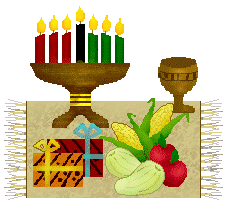 |
Symbols
of Kwanzaa |
Kwanzaa is a celebration that focusses on traditional African values of family, community responsibility, commerce, and self-improvement. It was established in America in 1966 by Dr Maulana Karenga, and since that time it has come to be observed by more than 18 million people worldwide.
A word meaning “first fruits of the harvest” in the African language Kiswahili, Kwanzaa lasts from 26 December to 1 January, and is based on seven guiding principles, one for each day of the festival’s observance:
| • | Unity, umoja, stressing the importance of togetherness for the family and the community. |
| • | Self-determination, kujichagulia, requiring that common interests are defined and decisions are made in the best interest of family and community. |
| • | Collective work and responsibility, ujima, reminding individuals of their obligation to the past, present and future, and that they have a role to play in the community, society, and world. |
| • | Cooperative economics, ujamaa, emphasising collective economic strength and encouraging individuals to meet common needs through mutual support. |
| • | Purpose, nia, encouraging people to look within themselves and to set personal goals that are beneficial to the community. |
| • | Creativity, kuumba, making use of creative energies to build and maintain strong and vibrant communities. |
| • | Faith, imani, focusing on honouring the best of a people’s traditions, and helping individuals strive for a higher level of life for humankind by affirming self-worth and confidence in the ability to succeed and triumph in righteous struggle. |
As
seen in the illustration, seven
symbolic objects have come to be associated with the observance of Kwanzaa:
the mkeka, the straw mat on which all other objects are placed;
the mazao (fruits and vegetables), which symbolize the harvest
origins of the holiday; the kinara, which is a candle holder
for the mishumaa, the three green, three red and one black candle
that represent the nguzo saba, or seven priniciples; muhindi,
ears of corn representing the children in the house and community; kikombe
cha umoja, the ‘unity cup’ and zawadi, gifts
for the children, which should always include a book and a heritage symbol.